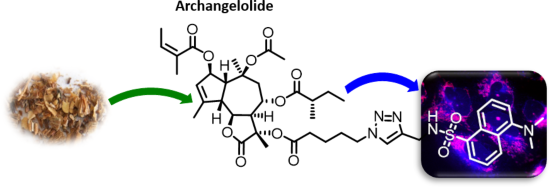Search results
Search for "pDNA" in Full Text gives 5 result(s) in Beilstein Journal of Organic Chemistry.
Archangelolide: A sesquiterpene lactone with immunobiological potential from Laserpitium archangelica
Beilstein J. Org. Chem. 2019, 15, 1933–1944, doi:10.3762/bjoc.15.189

- -specific dye from [20] (10 min; image C) or pDNA coding mCherry-ER (image G). D, H) merged images. Cartoon representation of sarco/endoplasmic reticulum Ca2+ ATPase binding pocket with A, C) archangelolide (1) or B, D) trilobolide (2) after molecular dynamic simulations. Depicted are also amino acid
Binding abilities of polyaminocyclodextrins: polarimetric investigations and biological assays
Beilstein J. Org. Chem. 2017, 13, 2751–2763, doi:10.3762/bjoc.13.271
- our materials to exploit both the cavity and the polycationic branches, thus functioning as bimodal ligands. Keywords: aminocyclodextrins; binding properties; nitroanilines; pDNA; polarimetry; supramolecular chemistry; Introduction Polyamine macromolecules have attracted a widespread interest for
- plasmid DNA. For this, each AmCD was mixed with pDNA at various N/P ratios (average number of nitrogen atoms on the cyclodextrin core/number of phosphate groups of pDNA) and the complexation efficiency was evaluated by electrophoretic mobility shift assays (EMSA). When electrophoresis is applied to pDNA
- , different forms may be detected, i.e., the circular, linear and supercoiled topoisomers (Figure 8; in some preparations of pDNA, even after RNAse treatment, RNA can be present). Two sets of experiments were carried out: the first one (Figure 8a) with the same N/P ratios for each AmCD, and the second one
Synthesis of a resin monomer-soluble polyrotaxane crosslinker containing cleavable end groups
Beilstein J. Org. Chem. 2014, 10, 2623–2629, doi:10.3762/bjoc.10.274

- PRXs with cleavable disulfide end groups can form stable complexes with negatively charged biomacromolecules such as proteins, pDNA, or siRNA [11][12][13][14][15]. These PRX–biomolecule complexes were successfully delivered into the cytoplasm, and the biomolecules were effectively released after the
Atherton–Todd reaction: mechanism, scope and applications
Beilstein J. Org. Chem. 2014, 10, 1166–1196, doi:10.3762/bjoc.10.117
Polyglycerol-functionalized nanodiamond as a platform for gene delivery: Derivatization, characterization, and hybridization with DNA
Beilstein J. Org. Chem. 2014, 10, 707–713, doi:10.3762/bjoc.10.64

- confirmed by gel retardation assay that ND-PG-Arg8 and ND-PG-Lys8 with higher zeta potential hybridized with plasmid DNA (pDNA) through electrostatic attraction, making them promising as nonviral vectors for gene delivery. Keywords: carbon-nanomaterials; click chemistry; DNA; gene delivery; nanodiamond
- , Lys8 and His8) through click chemistry followed by hybridization with plasmid DNA (pDNA) and its characterization by electrophoresis is reported. Results and Discussion Preparation and characterization of ND50-PG In view of actual cancer therapy utilizing the enhanced permeation and retention (EPR
- . However, ND-PG-BPP still has dispersibility of >1.0 mg/mL with less stability (Figure 5). Zeta potential characterization and pDNA complexation To analyze the surface charge of the nanoparticles, we measured the zeta potential of ND50, ND50-PG and ND-PG-BPP at neutral pH in Milli-Q water. The results are

























































































